Projects include healthcare, infrastructure and faith of the founding fathers
Opportunities for undergraduates to pursue significant research projects is a hallmark of the student experience at the University of Missouri-Kansas City. During April, 10 UMKC students displayed their research projects publicly during Legislative Day at the state capitol in Jefferson City, along with students from the other three campuses of the University of Missouri System.
UM System students are provided unique opportunities to work directly alongside leading faculty to conduct groundbreaking research every day. These experiences, which range from science to medicine to the humanities, help to prepare our students for graduate and professional studies at prominent universities as well as careers in leading industries. Undergraduate Research Day at our state’s capitol illustrates these student accomplishments and allows our elected officials to see—firsthand—the exciting innovations our students are producing to build their careers while benefitting our communities.
Here’s a look at the featured research projects:
Discovery of novel therapeutic targets for disease treatment
Student: Sarah Rapp
Faculty mentor: Ryan Mohan, assistant professor of biological sciences
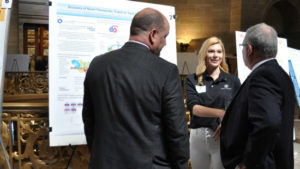 Rapp’s research is aimed at understanding the processes that drive cancer and neurodegenerative diseases, down to the molecular level. Understanding these processes is the key to developing more effective treatments for these diseases.
Rapp’s research is aimed at understanding the processes that drive cancer and neurodegenerative diseases, down to the molecular level. Understanding these processes is the key to developing more effective treatments for these diseases.
She is studying a key player in the cellular processes associated with these diseases, the SAGA complex. This multi-protein complex is involved in processes such as DNA damage repair, cell cycle control and regulation of proteins associated with cancer, including tumor suppressors. Abnormalities within the SAGA complex can cause neurodegeneration, progressive loss of vision leading to blindness, and loss of muscle coordination. The goal is understanding how the interactions of the proteins are altered when the complex malfunctions. That knowledge will allow us target them and restore their function. With a better understanding of the proteins the SAGA complex interacts with, we progress towards an ultimate goal of new therapeutic treatments and improvement of human health.
Rapp is a junior studying biotechnology.
Genomic engineering for the analysis of multiprotein complexes regulating neural stability
Student: Joseph Allen
Faculty mentor: Ryan Mohan, assistant professor of biological sciences
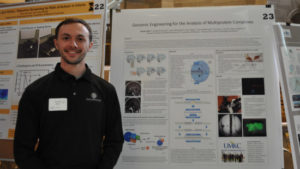 Allen is researching nine neurodegenerative diseases that are caused by the expansion of nucleotide sequences in a group of seemingly unrelated genes. These expansions result in progressive degeneration of the central nervous system and, in Spinocerebellar Ataxia 7 (SCA7), the retina and macula – structures within the eye. With no current treatments available, these diseases lead to critical loss of motor control, blindness, and death.
Allen is researching nine neurodegenerative diseases that are caused by the expansion of nucleotide sequences in a group of seemingly unrelated genes. These expansions result in progressive degeneration of the central nervous system and, in Spinocerebellar Ataxia 7 (SCA7), the retina and macula – structures within the eye. With no current treatments available, these diseases lead to critical loss of motor control, blindness, and death.
Allen and his team are focused on advancing our knowledge of the Ataxin-7 protein, and understanding the factors that lead to the development of SCA7. These insights are applicable to the development of potential treatments, pathogenesis (the biological mechanisms behind disease), as well as oncology (cancer). The team is using advanced gene-editing technology on brain cells of flies to create models for studying neural stability and potentially discovering novel neuroprotective mechanisms.
Allen is a sophomore studying biology.
Attack of bone infections: An alternative to commercial bone cements
Student: Megan Connor
Faculty mentor: Kathleen Kilway, chemistry professor
 The number of knee and hip replacements are fast on the rise and expected to keep increasing. The number of infections from complications also is expected to rise; however, the current antibiotic-incorporated bone cement has high curing temperatures and is toxic. Connor is part of a research team that has developed an alternative non-toxic bone cement that cures below body temperature while maintaining mechanical strength.
The number of knee and hip replacements are fast on the rise and expected to keep increasing. The number of infections from complications also is expected to rise; however, the current antibiotic-incorporated bone cement has high curing temperatures and is toxic. Connor is part of a research team that has developed an alternative non-toxic bone cement that cures below body temperature while maintaining mechanical strength.
Connor is a senior majoring in biology and chemistry.
Investigating the role of Jaspine B on the function of ceramide transfer protein
Student: Melody Kimbrough
Faculty mentor: XiaoLan Yao, assistant biology professor
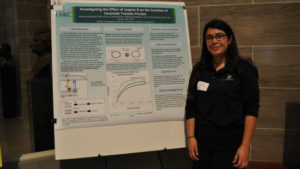 In the U.S., more people are diagnosed with skin cancer, melanoma, than all other cancers combined. Understanding how a ceramide transfer protein work could not only help combat melanoma cells, but also fight the Hepatitis C virus and chlamydia. The study examined Jaspine B, a marine sponge that could help promote the death of cancer cell lines and be used as a chemotherapeutic agent for cutaneous melanoma, one of the most aggressive forms of skin cancer.
In the U.S., more people are diagnosed with skin cancer, melanoma, than all other cancers combined. Understanding how a ceramide transfer protein work could not only help combat melanoma cells, but also fight the Hepatitis C virus and chlamydia. The study examined Jaspine B, a marine sponge that could help promote the death of cancer cell lines and be used as a chemotherapeutic agent for cutaneous melanoma, one of the most aggressive forms of skin cancer.
Kimbrough is a senior majoring in chemistry.
Using drone technology and imaging software to track the locations of boulders on the island of San Salvador, the Bahamas and concrete slabs in Brush Creek, Kansas City
Student: Stephanie Caples
Faculty mentor: Tina Niemi, geosciences professor
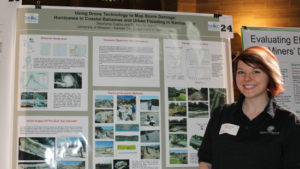 Wave generated energy of tropical storms is capable of moving boulders of various sizes across shorelines and into the mainland, which shapes the development of the shore platforms in coastal regions. Relatively little is currently known about the magnitude of the waves on shorelines during tropical storms, but by utilizing long-term monitoring of boulders throughout storm surge cycles valuable information can be collected, which can be used to protect infrastructure and save lives. In urban areas, where above-ground water sources are kept in place by man-made means, many similarities to the boulders being moved along shorelines are found. In the same way that boulders are ripped up during tropical storms, concrete slabs can be ripped up during floods and transported downstream which degrades stream stability over time. By comparing the boulder movement patterns on San Salvador due to tropical storms to the concrete slab movement of Brush Creek in Kansas City due to floods, a fuller understanding of the energies in affect during these events can be determined, which will help to establish more appropriate engineering practices for these environments in the future.
Wave generated energy of tropical storms is capable of moving boulders of various sizes across shorelines and into the mainland, which shapes the development of the shore platforms in coastal regions. Relatively little is currently known about the magnitude of the waves on shorelines during tropical storms, but by utilizing long-term monitoring of boulders throughout storm surge cycles valuable information can be collected, which can be used to protect infrastructure and save lives. In urban areas, where above-ground water sources are kept in place by man-made means, many similarities to the boulders being moved along shorelines are found. In the same way that boulders are ripped up during tropical storms, concrete slabs can be ripped up during floods and transported downstream which degrades stream stability over time. By comparing the boulder movement patterns on San Salvador due to tropical storms to the concrete slab movement of Brush Creek in Kansas City due to floods, a fuller understanding of the energies in affect during these events can be determined, which will help to establish more appropriate engineering practices for these environments in the future.
Caples is a fall 2017 graduate who studied geology.
In-home technology for longitudinal health monitoring
Student: Shannon Howard
Faculty mentor: Joan McDowd, psychology professor
There is a recent movement to increase the use of technology in the lives of older adults with the aim of helping them age in place. Tech-enabled living could provide an attractive alternative to more costly and dependent care, as well as serve as a tool to detect early cognitive and physical impairment. The long-term goal of this project is to assess the feasibility of using in-home technology for longitudinal health monitoring.
Howard is a senior psychology major.
I mean to do that: the intentionality of tool marks on ancient Greek tombstones
Student: Carolyn Nordengren
Faculty mentor: Robert Cohon, visiting research associate professor of ancient art
 In the fifth and fourth centuries before the Common Era (BCE), Athenians erected marble stelai, slab-shaped tombstones, over their interred dead. These tombstones, typically between three and six feet high, were carved with images in relief. The depth of these reliefs ranged from a few inches to a foot or more. These images, often figural, were associated farewells between the living and the dead. This project examines the tool marks left behind in the ancient sculpting process. While sculptors would often use a rasp, a tool covered with a series of metal teeth, and abrasive powder to smooth out tool marks, in the case of stelai, tool marks can still be seen on the surface of the stone. Stelai were left unpolished which means that many tool marks left behind by the sculptor are still visible, provided the stone is in good condition. The research set out to determine why ancient sculptors removed some tool marks and not others. During six days of research at the Metropolitan Museum of Art in New York City, eight stelai were examined using a combination of visual and photographic examination. This examination occurred under both the natural lighting conditions of the galleries and with a flashlight. The contrast was also adjusted on photos taken in order to ease the identification of tool marks. The research concluded that as the size of the stelai and intended quality of their carving increased, sculptors removed more tool marks from the stone.
In the fifth and fourth centuries before the Common Era (BCE), Athenians erected marble stelai, slab-shaped tombstones, over their interred dead. These tombstones, typically between three and six feet high, were carved with images in relief. The depth of these reliefs ranged from a few inches to a foot or more. These images, often figural, were associated farewells between the living and the dead. This project examines the tool marks left behind in the ancient sculpting process. While sculptors would often use a rasp, a tool covered with a series of metal teeth, and abrasive powder to smooth out tool marks, in the case of stelai, tool marks can still be seen on the surface of the stone. Stelai were left unpolished which means that many tool marks left behind by the sculptor are still visible, provided the stone is in good condition. The research set out to determine why ancient sculptors removed some tool marks and not others. During six days of research at the Metropolitan Museum of Art in New York City, eight stelai were examined using a combination of visual and photographic examination. This examination occurred under both the natural lighting conditions of the galleries and with a flashlight. The contrast was also adjusted on photos taken in order to ease the identification of tool marks. The research concluded that as the size of the stelai and intended quality of their carving increased, sculptors removed more tool marks from the stone.
Nordengren is a junior studying art history.
Exploring women’s communication with public figures: a study of Angelica Schuyler Church’s letters to founding fathers
Student: Anne Crawford
Faculty mentor: Jane Greer, professor of English and women’s and gender studies
Crawford’s study aims to promote research on women’s writing in the American republic as well as additional research on how women use the written word to interact with political figures. She examined the writings of Angelica Schuyler Church, an eighteenth century woman who used three writing styles to navigate the social and political restrictions society imposed on women during her lifetime so that she could express her opinions without fear of backlash. Anne proposed that while recovering women writers like Schuyler Church is critical to understanding America’s past, the current figuration of women in sites of public memory raises questions about how their past contributions to civic life are analyzed and interpreted in the present.
Crawford is a senior studying English.
Effect of water to cement ratio on pervious concrete performance
Student: Shana Malone
Faculty mentor: John Kevern, associate professor of engineering
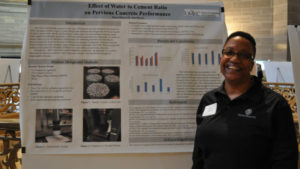 Pervious concrete is a type of hardened concrete designed with about 20 percent to 30 percent void space to allow water to soak through and infiltrate the ground. While pervious concrete is not uncommon, some of the basic relationships needed for proper design are still unknown.
Pervious concrete is a type of hardened concrete designed with about 20 percent to 30 percent void space to allow water to soak through and infiltrate the ground. While pervious concrete is not uncommon, some of the basic relationships needed for proper design are still unknown.
Malone’s project tested the hypothesis that if void content and workability are controlled, then an optimum water to cement ratio could be developed. Her project consisted of mixing five batches of concrete mixes, each with different amounts of high range water reducer. There were nine cylinders made for each batch of concrete. Each mix was tested for strength, amount of void space and how much water was allowed to pass through it.
Malone is a senior studying civil engineering.
Expanding applications of green fluorescent protein expression to include criminal justice reform
Student: Laurie Ray
Faculty mentor: Samuel Bouyain, associate professor of biological sciences
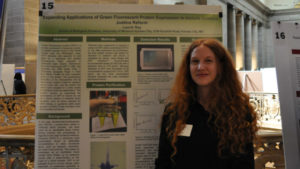 Green fluorescence protein (GFP) is expressed in Aequorea Victoria, a jellyfish species found off the Washington coast. GFP interacts with aequorin to give off light and fluoresce when exposed to ultraviolet light. GFP’s non-toxicity makes it ideal for research in living cells, and the protein has been adapted for a wide variety of biological sciences applications. Ray’s research aimed to expand the applications of GFP to include it as a marker in blood samples collected for DNA testing or CODIS profile formation from incarcerated persons. Her project proved that GFP, as opposed to EDTA, which is a commonly used preservative found at detectable concentrations in many household cleaners, is more easily detected. Therefore Ray suggests GFP an ideal candidate for a blood marker.
Green fluorescence protein (GFP) is expressed in Aequorea Victoria, a jellyfish species found off the Washington coast. GFP interacts with aequorin to give off light and fluoresce when exposed to ultraviolet light. GFP’s non-toxicity makes it ideal for research in living cells, and the protein has been adapted for a wide variety of biological sciences applications. Ray’s research aimed to expand the applications of GFP to include it as a marker in blood samples collected for DNA testing or CODIS profile formation from incarcerated persons. Her project proved that GFP, as opposed to EDTA, which is a commonly used preservative found at detectable concentrations in many household cleaners, is more easily detected. Therefore Ray suggests GFP an ideal candidate for a blood marker.
Ray is a senior studying biology and chemistry.

